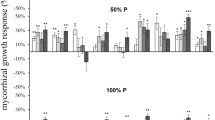Abstract
Santa Catarina state is the largest producer of apples in Brazil. Soils in this region have low pH and high levels of aluminum and manganese, requiring high inputs of fertilizers and amendments increasing costs of apple production. Inoculation of arbuscular mycorrhizal fungi can improve the establishment of micropropagated apple plants in such adverse soil conditions. Soil samples were collected from apple orchards in the Caçador, Fraiburgo and São Joaquim regions to develop a corn bioassay to identify mycorrhizal communities with high infectivity. Eleven fungal species were identified from one Caçador soil with the highest infectivity. Glomus etunicatum SCT110, Scutellospora pellucida SCT111, Acaulospora scrobiculata SCT112 and Scutellospora heterogama SCT113 were brought into single-species culture and used in a plant growth and nutrient uptake experiment using micropropagated apple (Malus prunifolia), cultivated at three soil pH. Colonization by fungal isolates significantly affected plant height, shoot and root dry weights, and root:shoot ratio. Soil pH also significantly affected all growth parameters except shoot dry weight. Mycorrhizal inoculation also significantly altered tissue concentrations of P, Zn, Cu, Ca, S, Na, N, K, Fe and Al. Association with mycorrhizal fungi increased P concentration and also decreased Al concentrations in the shoots. Overall, G. etunicatum and S. pellucida were the most effective isolates to promote plant growth and nutrient uptake. Inoculation of apple rootstock with selected fungal isolates during the acclimatization stage represents a useful strategy for producing micropropagated apples that can withstand acidic soil conditions.


Similar content being viewed by others
References
Abbott LK, Robson AD (1981) Infectivity and effectiveness of vesicular–arbuscular mycorrhizal fungi: effect of inoculum type. Aust J Agric Res 32:631–639
Arines J, Vilariño A, Sainz M (1989) Effect of different inocula of vesicular–arbuscular mycorrhizal fungi on manganese content and concentration in red clover (Trifolium pratense L.) plants. New Phytol 112:215–219
Basso C, Suzuki A (1992) Resposta da macieira cv. Golden Delicious à adubação nitrogenada. Rev Bras Ciência Solo 16:223–227
Basso C, Wilms FWW, Suzuki A (1986) Fertilidade do solo e nutrição de macieira. In: Manual da Cultura da Macieira. EPAGRI, Florianópolis
Bever JD, Morton JB, Antonovics J, Schultz PA (1996) Host-dependent sporulation and species diversity of arbuscular mycorrhizal fungi in a mown grassland. J Ecol 84:71–82
Bolan NS (1991) A critical review on the role of mycorrhizal fungi in the uptake of phosphorus by plants. Plant Soil 134:189–207
Borie F, Rubio R (1999) Effects of arbuscular mycorrhizae and liming on growth and mineral acquisition of aluminum-tolerant and aluminum-sensitive barley cultivars. J Plant Nutr 22:121–137
Branzanti B, Gianinazzi-Pearson V, Gianinazzi S (1992) Influence of phosphate fertilization on the growth and nutrient status of micropropagated apple infected with endomycorrhizal fungi during the weaning stage. Agronomie 12:841–845
Clark RB, Zeto SK (1996) Mineral acquisition by mycorrhizal maize grown on acid and alkaline soil. Soil Biol Biochem 28:1495–1503
El-Kherbawy M, Angle JS, Heggo A, Chaney RL (1989) Soil pH, rhizobia, and vesicular–arbuscular mycorrhizae inoculation effects on growth and heavy metal uptake of alfafa (Medicago sativa L.). Biol Fertil Soils 8:61–65
EMBRAPA (1999) Sistema Brasileiro de Classificação de Solos. Serviços de Produção de Informações, Brasilia, DF, pp. 412
Fortuna P, Citernesi S, Morini S, Giovannetti M, Loreti F (1992) Infectivity and effectiveness of different species of arbuscular mycorrhizal fungi in micropropagated plants of Mr S 2/5 plum rootstock. Agronomie 12:825–829
Geddeda YI, Trappe JM, Stebbins RL (1984) Effects of vesicular–arbuscular mycorrhizae and phosphorus on apple seedlings. J Am Soc Hortic Sci 109:24–27
George EF (1996) Plant propagation by tissue culture—Part 2 in practice. Exegetics Limited, England, pp. 575–1361
Gerdemann JW, Nicolson TH (1963) Spores of mycorrhizal Endogone species extracted from soil by wet sieving and decanting. Trans Br Mycol Soc 46:235–244
Giovannetti M, Mosse B (1980) An evaluation of techniques for measuring vesicular arbuscular mycorrhizal infection in roots. New Phytol 84:489–500
Graham JH, Linderman RG, Menge JA (1982) Development of external hyphae by different isolates of mycorrhizal fungi Glomus spp. in relation to root colonization and growth of troyer citrange. New Phytol 91:183–189
Granger RL, Plenchette C, Fortin JA (1983) Effect of a vesicular arbuscular (VA) endomycorrhizal fungus (Glomus epigaeum) on the growth and leaf mineral content of two apple clones propagated in vitro. Can J Plant Sci 63:551–555
Grattapaglia D, Machado MA (1991) Micropropagação. In: Torres AC, Caldas LS, Boso JA (eds) Cultura de Tecidos e Transformação Genética de Plantas. EMBRAPA, Brasilia, pp. 183–204
Guillemin JP, Gianinazzi S, Trouvelot A (1992) Screening of arbuscular endomycorrhizal fungi for establishment of micropropagated pineapple plants. Agronomie 12:831–836
Habte M, Soedarjo M (1996) Response of Acacia mangium to vesicular–arbuscular mycorrhizal inoculation, soil pH, and soil P concentration in an oxisol. Can J Bot 74:155–161
Johnson NC (1993) Can fertilization of soil select less mutualistic mycorrhizae? Ecol Appl 3:749–757
Johnson NC, Graham JH, Smith FA (1997) Functioning of mycorrhizal associations along the mutualism–parasitism continuum. New Phytol 135:575–585
Koske RE, Gemma JN (1989) A modified procedure for staining roots to detect VA mycorrhizas. Mycol Res 92:486–505
Lambert DH, Cole H Jr, Baker DE (1980) Adaptation of vesicular–arbuscular mycorrhizal to edaphic factors. New Phytol 85:513–520
Lovato P, Guillemin JP, Gianinazzi S (1992) Application of commercial arbuscular endomycorrhizal fungal inoculants to the establishment of micropropagated grapevine rootstock and pineapple plants. Agronomie 12:873–880
Mamo T, Killham KS (1987) Effect of soil liming and vesicular–arbuscular mycorrhizal inoculation on the growth and micronutrient content of the teff plant. Plant Soil 102:257–259
Marschner H (1991) Mechanisms of adaptation of plants to acid soils. Plant Soil 134:1–20
Melo FAF (1985) Origem, natureza e componentes da acidez do solo: critérios para calagem. In: Malavolta E (ed) Seminário sobre corretivos agricolas. Piracicaba, Fundação Cargill
Mendoza J, Borie F (1998) Effect of Glomus etunicatum on aluminum, phosphorus, calcium and magnesium uptake of two barley genotypes with different aluminum tolerance. Commun Soil Sci Plant Anal 29:681–695
Miller DD, Domoto PA, Walker C (1985) Colonization and efficacy of different endomycorrhizal fungi with apple seedlings at two phosphorus levels. New Phytol 100:393–402
Moorman T, Reeves FB (1979) The role of endomycorrhizae in revegetation practices in the semi-arid west. II. A bioassay to determine the effect of land disturbance on endomycorrhizal populations. Am J Bot 66:14–18
Morton JB (1993) Problems and solutions for the integration of glomalean taxonomy, systematic biology, and the study of endomycorrhizal phenomena. Mycorrhiza 2:97–109
Morton JB, Bentivenga SP, Wheeler WW (1993) Germplasm in the International Collection of Arbuscular and Vesicular–arbuscular Mycorrhizal Fungi (INVAM) and procedures for culture development, documentation and storage. Mycotaxon 48:491–528
Nunes JCO, Barpp A, Silva FC, Pedrotii EL (1991) Micropropagação do porta-enxerto Marubakaido (Malus prunifolia) a partir da cultura de meristemas. Rev Bras Frutic 21:191–195
O’Donnell JJ, Sylvia DM, Pitman WD, Rechcigl JE (1992) Inoculation of Vigna parketi with mycorrhizal fungi in acid Florida spodsol. Trop Grass 26:120–129
Plenchette C, Furlan V, Fortin JA (1981) Growth stimulation of apple trees in unsterilized soil under field conditions with VA mycorrhiza inoculation. Can J Bot 59:2003–2008
Plenchette C, Fortin JA, Furlan V (1983) Growth responses of several plant species to mycorrhizae in a soil of moderate P fertility. Plant Soil 70:199–209
Ravolanirina F, Gianinazzi S, Trouvelot A, Carre M (1989) Production of endomycorrhizal explants of micropropagated grapevine rootstocks. Agric Ecosyst Environ 29:323–327
Sainz MJ, Arines J (1988) Effects of native vesicular–arbuscular mycorrhizal fungi and phosphate fertilizer on red clover growth in acid soils. J Agric Sci 111:67–73
Sieverding E (1991) Vesicular–arbuscular mycorrhiza management in tropical ecosystems. Deutsche Geselleschaft für Technische Zusammenarbeit, Eschborn
Sieverding E, Howeler RH (1985) Influence of species of VA mycorrhizal fungi on cassava yield response to phosphorus fertilization. Plant Soil 88:213–221
Siqueira JO, Colozzi-Filho A, Oliveira E (1989) Ocorrência de micorrizas vesicular–arbusculares em agro e ecossistemas do estado de Minas Gerais. Pesqui Agropecuaria Bras 24:1499–1506
Soedarjo M, Habte M (1993) Vesicular–arbuscular mycorrhizal effectiveness in an acid soil amended with fresh organic matter. Plant Soil 149:197–203
Smith SE, Read DJ (1997) Mycorrhizal symbiosis. Academic, London, pp. 605
Stutz JC, Morton JB (1996) Successive pot cultures reveal high species richness of arbuscular endomycorrhizal fungi in arid ecosystems. Can J Bot 74:1883–1889
Tedesco MJ, Gianello C, Bissani CA, Bohnen H, Volkweiss SJ (1995) Análise de solo, planta e outros materiais. Universidade Federal do Rio Grande do Sul, Porto Alegre
Uosukainen M, Vestberg M (1994) Effect of inoculation with arbuscular mycorrhizas on rooting, weaning and subsequent growth of micropropagated Malus (L.) Moench. Agric Sci Finl 3:269–279
Weissenhorn I, Leyal C (1995) Root colonization of maize by a Cd-sensitive and a Cd-tolerant Glomus mosseae and cadmium uptake in sand culture. Plant Soil 175:233–238
Weissenhorn I, Leyal C, Berthelin J (1995) Bioavailability of heavy metals and abundance of arbuscular mycorrhiza in a soil polluted by atmospheric deposition from a smelter. Biol Fertil Soils 19:22–28
Acknowledgments
This work is part of the requirements of the senior author for a M.S. degree in biotechnology. This project was funded by FINEP (Financiadora de Estudos e Projetos, Brazil). We thank CAPES (Coordenação de Aperfeiçoamento de Pessoal de Nível Superior, Ministério de Ciência e Tecnologia, Brazil) and CNPq (Conselho Nacional de Desenvolvimento Cientifico e Tecnologico) for providing scholarships to JRPC during his graduate studies and to SLS as a Post-doctoral researcher. We are grateful to Dr Enio Pedrotii for providing micropropagated apple seedlings, and to Dr Clori Basso (EPAGRI, Caçador, SC) for technical support while the soils were sampled. We thank Drs P.E. Lovato and R.G. Linderman for valuable suggestions made to an earlier version of the manuscript. The document was subjected to the peer and administrative reviews of the U.S. EPA at the National Health and Environmental Effects Research Laboratory, Western Ecology Division, and was approved for publication. Mention of trade names or commercial products in this paper does not constitute endorsement or recommendation of use.
Author information
Authors and Affiliations
Corresponding author
Rights and permissions
About this article
Cite this article
Cavallazzi, J.R.P., Filho, O.K., Stürmer, S.L. et al. Screening and selecting arbuscular mycorrhizal fungi for inoculating micropropagated apple rootstocks in acid soils. Plant Cell Tiss Organ Cult 90, 117–129 (2007). https://doi.org/10.1007/s11240-006-9163-6
Received:
Accepted:
Published:
Issue Date:
DOI: https://doi.org/10.1007/s11240-006-9163-6




